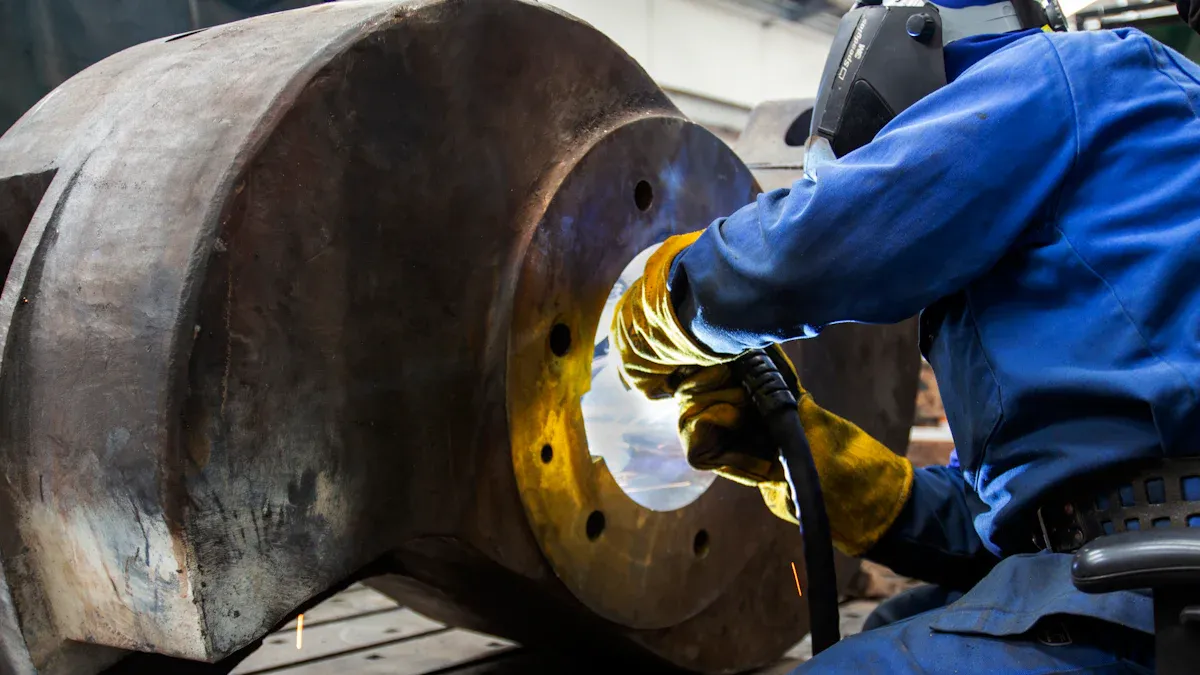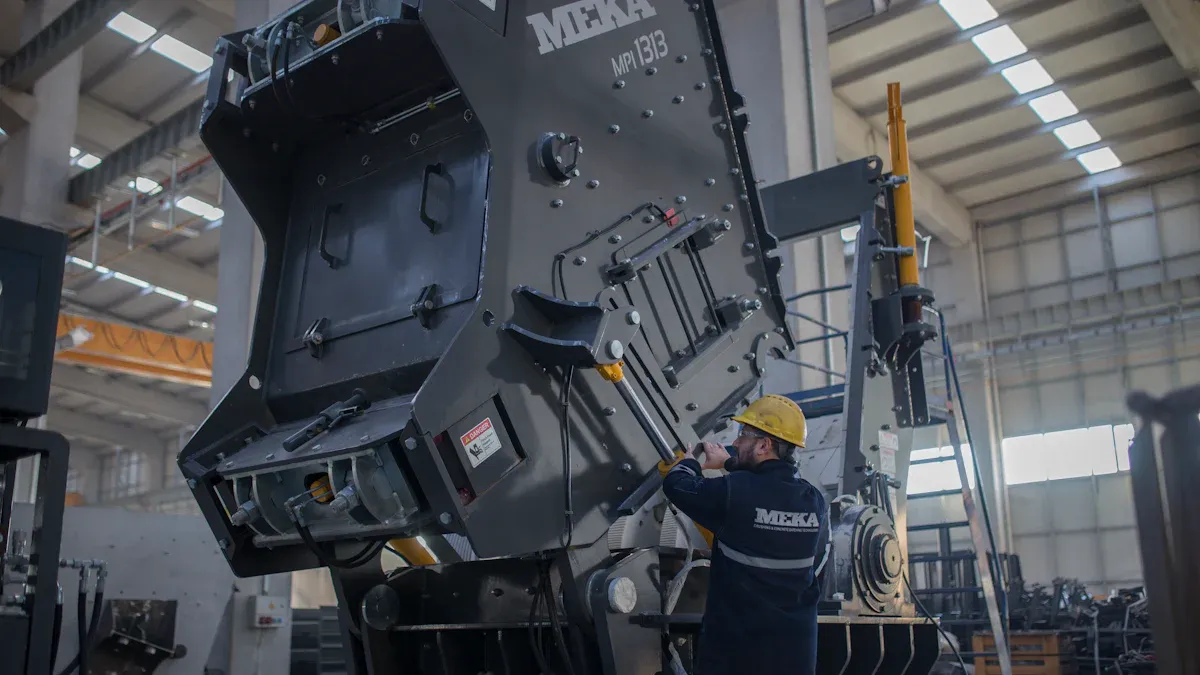
Proper replacement of jaw crusher parts plays a critical role in maintaining efficiency and avoiding costly downtime. You can prevent unexpected breakdowns by identifying worn-out components early and replacing them promptly. Using high-quality replacement parts offers significant advantages:
Save up to 20% annually on maintenance costs by optimizing performance right from the start.
Extend part lifespan by up to 30%, reducing the frequency of replacements.
Minimize downtime by up to 30% compared to cheaper alternatives.
Proactive maintenance ensures your jaw crusher operates efficiently for years, reducing costs and increasing productivity.

Understanding the key components of a jaw crusher helps you identify which parts may need replacement. Each part plays a vital role in the machine's operation:
Jaw Plates: These break down materials and are made of durable manganese steel.
Swing Jaw: This moving part crushes material by moving back and forth.
Pitman: It connects the swing jaw to the eccentric shaft, delivering the force needed for crushing.
Frame: Provides stability and supports all other components.
Eccentric Shaft: Rotates to create the motion required for crushing.
Bearings: Reduce friction and ensure smooth operation. Regular lubrication is essential.
Flywheel: Stores energy and maintains momentum for efficient crushing.
Wedges and Tension Rods: Secure the movable jaw and keep it aligned during operation.
Lubrication System: Reduces friction and extends the lifespan of moving parts.
Regular inspections of these components ensure your jaw crusher operates efficiently and safely.
Spotting wear and damage early prevents costly repairs and downtime. Look for these common signs:
Decreased Crushing Efficiency: If the machine struggles to crush material, the jaw plates or liners may be worn.
Visible Cracks or Deformations: Inspect the frame, swing jaw, and pitman for cracks or bending.
Unusual Vibrations or Noises: These often indicate issues with the bearings, flywheel, or eccentric shaft.
Reduced Tooth Height on Liners: Replace liners when the tooth height falls below 3/8 inch.
Frequent Blockages: This could mean the liner configuration is unsuitable for the material being processed.
Timely detection of these issues ensures your jaw crusher remains reliable and productive.
Tip: Regularly measure liner wear and replace them before they cause damage to other components.
Choosing the right replacement parts ensures your jaw crusher performs at its best. Consider these factors:
Liner Profile: Select a profile that matches your application. For example, anti-slab liners work well for materials prone to slab formation.
Manganese Content: The feed material determines the optimal manganese percentage for liners. Higher manganese content improves wear resistance for abrasive materials.
Durability Standards: Look for parts tested under ASTM G81-97a(2018), which evaluates gouging abrasion resistance.
Manufacturer Reputation: Purchase parts from reputable manufacturers to ensure quality and compatibility.
| Aspect | Description |
|---|---|
| Standard | ASTM G81-97a(2018) |
| Test Method | Jaw Crusher Gouging Abrasion Test |
| Significance and Use | This test ranks materials based on wear life for gouging abrasion, relevant in crushing equipment and mining applications. |
| Scope | Covers procedures to determine the abrasion resistance of materials, including homogeneous and composite materials. |
Investing in high-quality parts reduces downtime, enhances performance, and extends the lifespan of your jaw crusher.
Proper preparation ensures a smooth and safe replacement process. Start by shutting down the jaw crusher and disconnecting its power supply. This step prevents accidental operation during maintenance. Next, clean the machine thoroughly to remove dust, debris, and leftover material. A clean surface allows you to inspect components more effectively.
Inspect the crusher for any loose bolts, cracks, or other visible damage. Tighten bolts and address minor issues before proceeding. Gather all necessary tools and replacement parts in advance. Having everything ready minimizes delays and ensures the process runs efficiently.
Tip: Always wear appropriate personal protective equipment (PPE), such as gloves, goggles, and a hard hat, to ensure safety during the replacement process.
Follow these steps to replace jaw crusher parts effectively:
Remove Worn Components: Begin by loosening and removing the worn parts, such as jaw plates or liners. Use the appropriate tools to avoid damaging adjacent components.
Inspect Adjacent Parts: Check nearby components for wear or damage. Replace any parts showing significant wear to prevent future issues.
Install New Parts: Position the replacement parts carefully. Ensure they align correctly with the machine's specifications. Secure them tightly to avoid misalignment during operation.
Lubricate Moving Parts: Apply the recommended lubricant to bearings, shafts, and other moving parts. Proper lubrication reduces friction and extends the lifespan of the new components.
Reassemble the Crusher: Reattach all components and tighten bolts to the manufacturer's recommended torque settings.
Note: Refer to the user manual for specific instructions and torque values for your jaw crusher model.
After replacing the parts, conduct thorough testing to ensure the jaw crusher operates correctly. Start by running the machine without a load to check for unusual noises, vibrations, or misalignments. Gradually introduce material to verify the crusher's performance under normal operating conditions.
Schedule regular inspections to maintain the crusher's efficiency. Minor repairs, such as cleaning and liner adjustments, should occur every few weeks. Medium repairs, including part replacements, are typically performed annually. Overhauls, which involve replacing major components and calibrating the entire machine, should follow a long-term maintenance plan.
| Inspection Type | Description |
|---|---|
| 1000-hour Operating Inspection | Review of general condition, key wear components, and critical spare components without disassembly. |
| Wear Replacement Inspection | In-depth inspection of wear parts and other components when wears are replaced. |
| Annual Major Inspection | Detailed assessment of all major components with measurements, typically involving disassembly. |
Tip: Regular maintenance not only extends the lifespan of your jaw crusher but also reduces the risk of unexpected breakdowns.

Regular inspections are essential for keeping your jaw crusher in optimal condition. By identifying potential issues early, you can prevent costly repairs and extend the machine's lifespan. For example, routine servicing addresses wear and tear, ensuring smooth operation and reducing the risk of unexpected breakdowns.
| Inspection Frequency | Maintenance Tasks | Importance |
|---|---|---|
| Initial 40 hours post-commissioning | Check air filter, strainer basket, grease bearings | Ensures proper operation and prevents early failures |
| Regular 250-hour intervals | Daily inspections, check oil levels, monitor wear parts | Extends service life and minimizes downtime |
Integrating preventive maintenance systems, such as Caterpillar or HVI, can further enhance longevity. These systems use real-time data to optimize operations and reduce wear.
Tip: Keep a detailed maintenance log to track inspections and repairs. This helps you stay on top of routine tasks and identify patterns in wear and tear.
Operating your jaw crusher within its recommended parameters significantly improves efficiency and reduces wear. For instance:
Larger jaw box sizes increase throughput (Tons per Hour, TPH), making them ideal for high-output applications.
Smaller output sizes require more effort and time, reducing TPH.
The closed-side setting (CSS) affects throughput. A tighter CSS reduces TPH but ensures finer material output.
Material characteristics also play a role. Harder materials, measured by the Mohs scale, require more energy to crush, which can lower TPH. Choke feeding the crusher ensures uniform particle size and maximizes production capacity.
Note: Always refer to the manufacturer’s guidelines for optimal settings. This ensures safe and efficient operation.
Some replacements, such as eccentric shafts or pitman arms, require specialized knowledge. Consulting experts ensures these complex tasks are performed correctly. Professionals can also provide insights into advanced maintenance techniques and recommend high-quality replacement parts.
Callout: Partnering with experienced technicians reduces the risk of improper installations, which can lead to further damage.
Investing in expert advice not only saves time but also enhances the overall performance of your jaw crusher.
Timely replacement of jaw crusher parts ensures your equipment operates efficiently and avoids costly breakdowns. By using high-quality parts and following best practices, you can achieve significant benefits:
Minimized downtime through predictive maintenance, allowing repairs during non-operational hours.
Cost savings from early issue detection, avoiding expensive repairs and production losses.
Extended equipment lifespan, reducing the need for costly upgrades.
For example, Titan America reduced downtime by 30% with preventive maintenance, highlighting the financial and operational advantages. Adopting proactive strategies not only enhances productivity but also safeguards your investment in the long run.
Tip: Regular monitoring and scheduled maintenance tasks ensure your jaw crusher remains reliable and efficient for years to come.
You need basic tools like wrenches, screwdrivers, and a torque wrench. For larger components, use lifting equipment such as a hoist or crane. Always have safety gear like gloves, goggles, and a hard hat.
Inspect parts every 250 operating hours. Check for wear, cracks, and alignment issues. Regular inspections help you catch problems early and avoid costly repairs.
Yes, but choose high-quality aftermarket parts from reputable manufacturers. Poor-quality parts may reduce efficiency and cause damage to your crusher.
Replace jaw plates when the tooth height drops below 3/8 inch. Worn plates reduce crushing efficiency and can damage other components.
Perform regular maintenance, use proper lubrication, and operate the crusher within recommended parameters. These practices reduce wear and improve part longevity.
Tip: Keep a maintenance log to track inspections and replacements for better planning.